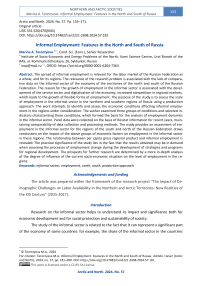Informal Employment: Features in the North and South of Russia
Автор: Terentyeva M.A.
Журнал: Arctic and North @arctic-and-north
Рубрика: Northern and arctic societies
Статья в выпуске: 57, 2024 года.
Бесплатный доступ
The spread of informal employment is relevant for the labor market of the Russian Federation as a whole, and for its regions. The relevance of the research problem is associated with the lack of comparative data on the informal sector of the economy of the territories of the north and south of the Russian Federation. The reason for the growth of employment in the informal sector is associated with the development of the service sector and digitalization of the economy, increased competition in regional markets, which leads to the growth of flexible forms of employment. The purpose of the study is to assess the scale of employment in the informal sector in the northern and southern regions of Russia using a production approach. The work attempts to identify and assess the economic conditions affecting informal employment in the regions under consideration. The author examined three groups of conditions and selected indicators characterizing these conditions, which formed the basis for the analysis of employment dynamics in the informal sector. Panel data were collected on the basis of Rosstat information for recent years, maintaining comparability of data collection and processing methods. The study provides an assessment of employment in the informal sector for the regions of the south and north of the Russian Federation draws conclusions on the impact of the above groups of economic factors on employment in the informal sector in these regions. The relationship between per capita gross regional product and informal employment is revealed. The practical significance of the study lies in the fact that the results obtained may be in demand when assessing the processes of employment change during the development of strategies and programs for regional development. The prospects for further research are determined by a more in-depth analysis of the degree of influence of the current socio-economic situation on the level of employment in the regions.
Informal sector, employment, north, south, production approach
Короткий адрес: https://sciup.org/148330025
IDR: 148330025 | УДК: 331.526(470)(045) | DOI: 10.37482/issn2221-2698.2024.57.181
Текст научной статьи Informal Employment: Features in the North and South of Russia
DOI:
Research on the informal sector helps to understand its impact and significance both for economic development and for social protection and sustainability of society.
The study of the informal sector is related to the fact that it can represent a significant part of the economy of some countries: for example, the share of the informal sector in the countries
∗ © Terentyeva M.A., 2024
This work is licensed under a CC BY-SA License of Eastern Europe and Central Asia in the structure of gross value added reaches 14.0% 1. However, the level of employment in the informal sector of the economy is also significant. People employed in the informal economy most often deal with unstable low incomes, limited social protection and face difficult working conditions. Therefore, a study of employment in the informal sector of the economy will help to assess not only its scale, but also to identify and understand the characteristics and problems of those working in the informal economy. The study of employment in the informal sector is a necessary tool for analyzing the economy and social reality in the regions. Thus, the relevance of this study is due to the lack of comparative data on employment in the informal sector in the territories of the north and south of the Russian Federation.
Theoretical aspects of informality in the labor market
The informal sector of the economy is understood as “a set of types of economic activity that are not fully or partially subject to state regulation, not supported by formal contracts and not recorded by statistical and tax accounting” 2. The objective condition for the emergence of the informal sector was its study in developing countries as a segment separate from the corporate structure, where regulation occurs according to other rules for the fulfillment of obligations. K. Hart laid the foundations for understanding the significance of the informal sector of the economy, which played a huge role in ensuring political stability and economic growth in developing countries. At the present stage, researchers of the informal sector study it as a phenomenon that differs in regions both in scale and in form, causality, and social composition 3. The informal sector of the economy has come to be seen as a characteristic of both developing and developed countries. It includes the economy, starting from households and ending with informal (criminal) practices [1, p. 27]. The concept of the “informal sector” is expanding and is becoming not an isolated segment of economic activity, but a basic component of the economic system.
There are three main approaches 4 to studying informality in the labor market. Firstly, it is the production approach, in which employment in the informal sector is studied based on the characteristics of the enterprise. Secondly, the legalist approach, which appeals to the characteristics of jobs when studying informal employment. And thirdly, there is the “hybrid approach”, which combines the logic of the two previously mentioned approaches.
Informal employment is opposed to formal employment [2]. Since the 1980s, it has been associated with high costs of legality [3]. Further, many studies are devoted to assessing informality by various indicators [4]. Thus, according to the resolution adopted by the International Labor
Organization 5, the scale of the informal sector can be assessed by the number of employees and registration in one or another legal form. In many countries, information on the number of employed in the economy is the most accessible, while statistical information on business registration has its own peculiarities, primarily related to its limitations and reliability. The main criterion for classifying an enterprise as informal is the number of hired personnel (not more than 5–7 people).
The economy of developing countries (such as Russia) is heterogeneous; researchers distinguish the “normal” economy (associated with the economic activity of state enterprises and transnational companies) and the “different” economy, dealing with peasant farms and small entrepreneurs. The population working in the informal sector in our country includes all those who work in unregistered enterprises. These include individual entrepreneurs without forming a legal entity (IE), employed by individuals and IEs, employed on an individual basis (without registering as IEs, self-employed and illegal), farms employed by individuals and IEs, as well as production in households for sale. Employment in the informal sector of the Russian Federation is approximately 20.0% [4]. Moreover, back in the 1970s, researchers of the informal sector noted its growth from east to west and from north to south of the country [5]. The state policy regarding informality in the labor market has been different in the post-Soviet history of the Russian Federation in different decades. Thus, in the 1990s, the state ignored the problem of informality. Later, in the 2000s, the position changed, and the emphasis was placed on economic growth, which should contribute to solving the problems of informality. Already in the 2010s, it became clear that automatic legalization did not occur, so the direction towards increasing the attention of the state to informality in the labor market was determined. The question of what constitutes a compromise in state policy towards the informal sector, which has such an advantage as the ability to self-organize away from the state, while simultaneously being the basis for the stability of social development, remains debatable. Researchers studying the informal and formal sectors of the economy propose the idea of the inseparability of the formal and informal order on the basis of institutional analysis [1, p. 22].
Institutionalists identify a socio-cultural factor that determines the economic development of territories [6]. As one of the main factors influencing the diversity of regional development, they highlight climate with its peculiarities of agricultural practices used in different climatic zones. For example, studies indicate an N-shaped relationship between temperature and “masculini-ty”/”femininity”, a tendency towards mass standard production or service activities and creativity. In a climate with average sharply high and low temperatures, there are “feminine” populations that recognize the need for consensus, care for others, service orientation, intuitive thinking, modesty and belonging to a certain community or group. “Masculine” populations live in a more favorable climate, since a huge number of ethnic groups flock there, resulting in high competition [7].
Thus, climatic conditions act as a powerful factor of differentiation in economic development [6], [7]. Research on Russian regions indicates significant differences in their socio-economic [8] and socio-cultural [9] development, which in turn affects the level of informality in the labor market.
Methodology and materials
The study mainly covers the period from 2010 to 2021. The work was carried out on the basis of systemic, institutional and production approaches. The empirical analysis was conducted in the northern and southern regions, which have specific features that are reflected in the assessments of socio-economic development. Russian regions are characterized by significant asymmetry of this development, dividing into rich and poor regions. This difference is especially noticeable when comparing the southern and northern territories. The northern regions include 6 the republics of Karelia, Komi, Tyva and Sakha (Yakutia), Arkhangelsk, Murmansk, Magadan and Sakhalin oblasts, Nenets, Khanty-Mansi, Yamalo-Nenets and Chukotka autonomous okrugs, as well as Kamchatka Krai (hereinafter referred to as the north of Russia). The southern regions include 7 the republics of Adygea, Kalmykia, Dagestan, Ingushetia, Kabardino-Balkaria, Karachay-Cherkessia, North Ossetia-Alania, Chechnya, Krasnodar Krai, Astrakhan, Volgograd and Rostov oblasts, as well as Stavropol Krai (hereinafter referred to as the south of Russia) [10]. The aim of the study was to analyze the characteristics of informal employment in the northern and southern regions of Russia. As a methodological basis of the study, we used general scientific methods of cognition: cause-and-effect and logical-structural analysis, economic and statistical methods (systematization of statistical information, compilation of an information and analytical database, etc.). Data processing was carried out using MS Excel.
Research results
When comparing the gross regional product (hereinafter GRP) of the south and north of the country, we notice that the southern regions are losing the competition to the northern regions by this indicator (Table 1).
Table 1
Gross regional product of the south and north of Russia 8
|
Area |
Value by year, billion rubles |
2010/ 2020 |
||||||
|
2010 |
2012 |
2015 |
2016 |
2017 |
2018 |
2020 |
||
|
Russian Federation |
37 687.8 |
49 926.0 |
65 750.6 |
69 237.7 |
74 798.9 |
84 976.7 |
93 810.3 |
2.5 |
|
South |
3 229.8 |
4 394.5 |
6 030.7 |
6 385.1 |
6 862.2 |
7 422.2 |
8 456.8 |
2.6 |
|
Share of the south in the RF |
8.6 |
8.5 |
8.8 |
9.2 |
9.3 |
9.2 |
9.2 |
- |
6 The northern regions include subjects the entire territory of which belongs to the regions of the Far North and equated localities.
7 The southern regions include subjects that are territorially part of the Southern and North Caucasian Federal Districts.
8 Source: calculated based on Rosstat data.
|
North |
5 087.6 |
6 367.1 |
8 710.9 |
9 062.8 |
10 114.6 |
12 596.9 |
11 558.2 |
2.3 |
|
Share of the north in the RF |
13.5 |
13.3 |
13.5 |
13.2 |
13.3 |
13.2 |
13.1 |
- |
According to official data from Rosstat, the contribution of the informal economy to the Russian Federation’s GDP in 2022 is estimated at 14.0–15.0%, but this figure varies across the regions, and in some southern regions it reaches 40.0–60.0% 9. Thus, the informal economy has great potential for legalization in most southern regions, but the mechanism used to equalize the budgetary provision of regions contributes to the preservation of dependent sentiments of poor regions [11]. Rosstat determines the contribution of the informal sector of the economy (the main criterion for determining informal sector units is the absence of state registration as a legal entity) to GDP on the basis of economic transactions that are not observed by direct statistical methods. But this is not a “shadow” or criminal economy. Shadow operations in the legal economy include situations when part of production is deliberately hidden from the attention of the state, for example, for tax evasion. The share of such shadow economy is about 4.0% of GDP 10. For example, Rosstat classifies production of subsidiary farms that grow goods on their plots for sale on the market as production in the informal sector. In addition, when calculating GDP, Rosstat also takes into account what we all produce for our own consumption (from vegetables, berries and mushrooms to self-repair of a car, etc.). Criminal production of goods and services is not included in the country’s GDP.
Unfavorable climatic conditions for living have caused an outflow of population from the north of the country. While before the 1990s the population of the north was growing, after the collapse of the USSR the migration outflow worsened, and in 1991–2020 the northern regions lost about 6.0% of their population 11.
The Central, Volga Federal Districts and, of course, the southern regions of the country, that is, territories with a more favorable climate, have become active “receiving” zones for northern migrants. Regional capitals and their suburbs are becoming “almost the only points of positive population dynamics in the overwhelming majority of Russian regions” [12]. In turn, the development potential of regional centers is determined by the availability of resources on the periphery — in cities and districts that serve as sources of migration growth for them [8; 13].
Institutionalists have identified that in territories comfortable for living, there are institutions oriented not on rent, but on other productive activities, when life is arranged for oneself [14]. Here, in the “receiving” regions of the south, the Krasnodar, Stavropol, Rostov and Volgograd agglomerations are emerging (despite the fact that in general the population in these regions was falling, with the exception of Krasnodar Krai, where the population grew by 10.0% (Table 2), while
Ibid.
the urban population was growing (Table 3)), and as a consequence, competition in such regions becomes more intense [14; 11].
Table 2
Population dynamics, thousand people 12
|
Area |
2010 |
2015 |
2020 |
|
South |
23 290 |
23 763 |
24 038 |
|
Krasnodar Krai |
5 230 |
5 514 |
5 684 |
|
Rostov Oblast |
4 275 |
4 236 |
4 181 |
|
Volgograd Oblast |
2 607 |
2 546 |
2 475 |
|
Stavropol Krai |
2 786 |
2 802 |
2 793 |
|
North |
7 915 |
7 859 |
7 815 |
Table 3
Urban population dynamics, thousand people 13
|
Area |
2010 |
2015 |
2020 |
|
South |
12 343 |
12 832 |
13 321 |
|
Krasnodar Krai |
2 767 |
2 994 |
3 160 |
|
Rostov Oblast |
2 877 |
2 872 |
2 851 |
|
Volgograd Oblast |
1 981 |
1 953 |
1 916 |
|
Stavropol Krai |
1 594 |
1 634 |
1 478 |
|
North |
6 095 |
6 130 |
6 174 |
The population of the southern regions of Russia in 2021 was 16.5% of the country’s population, while the population of the northern regions was 5.3%, which is three times less.
Researchers identify three conditions [8]: economic independence (the indicator of the share of employed in small business), economic resources (the share of the population above working age) and the level of education, which largely determine the behavior of the population in terms of both social independence and institutional structure. Below, we have analyzed these three conditions.
-
1) The share of people working in small businesses
2016
1 029.9
10.1
421.8
10.0
2017
1 112.6
10.8
438.4
10.8
2018
1 079.0
10.5
436.2
10.3
2019
1 136.7
11.1
445.7
11.3
2021
993.3
9.6
443.4
10.6
This indicator characterizes the level of independence of the population. Why is it so important? Because people working in small businesses are those who make economic decisions independently every day. How many of them are there in the total population? For example, in Moscow, every third resident works in small businesses (26–29%), in the south and north this figure is twice lower and is about 10–11% (Table 4).
Table 4 Dynamics of the number of employed in small enterprises in the southern and northern regions of Russia, 2010–2021 14
|
Year |
Southern regions |
Northern region |
||
|
thousand people |
share of total number of employed, % |
thousand people |
share of total number of employed, % |
|
|
2010 |
1 109.7 |
11.7 |
506.5 |
11.9 |
|
2012 |
1 130.2 |
11.8 |
482.3 |
11.3 |
|
2013 |
1 129.6 |
11.6 |
475.4 |
11.2 |
|
2014 |
1 135.5 |
11.9 |
454.6 |
10.8 |
12 Source: calculated based on Rosstat data.
13 Source: calculated based on Rosstat data.
14 Source: calculated based on Rosstat data.
Both in the south and in the north, the number of people employed in small businesses is characterized by a downward trend. While in the south of the country, employment in small businesses was growing before 2014, then after 2014, the number of employed in small enterprises here fell, and the decline continues to the present day; in general, over the past ten years, it has decreased by 10.5%. In the northern regions, the number fell from year to year, and over ten years, the decline was 12.5%. Thus, the level of independence of the majority of residents of the south and north can hardly be called high, and studies show that during crisis years, employment in the informal economy grows [4], since entrepreneurs reduce their costs by going into the “shadow” [8].
-
2) The proportion of the population over working age.
This indicator is important in terms of the risks of informal employment, as this age group has a rather high risk due to the specifics of human capital, health, etc. In the north, the population over the working age averaged 17.6% for 2005–2020, while in the southern regions this figure is higher — 20.1%. That is, in the south, every fifth resident is a pensioner. In the north, the retirement age is five years lower, that is, all other things being equal, there should be more pensioners in the north, but the migration factor plays a significant role: after retiring, people often move to more favorable regions for life, as a result, the share of the working age in the north is higher than in the south (Table 5).
Table 5
Dynamics of the proportion of the working-age population in the south and north of Russia, % 15
|
Area |
Share of the working-age population in the total population |
Employed working population in the total population |
||||
|
2010 |
2015 |
2020 |
2010 |
2015 |
2020 |
|
|
Russia |
61.5 |
57.4 |
56.0 |
47.3 |
48 |
49.7 |
|
North of Russia |
65.6 |
61.2 |
58.6 |
53.7 |
54.1 |
58.6 |
|
South of Russia |
60.7 |
57.1 |
55.7 |
37.6 |
36.1 |
31.2 |
The northern regions, despite a 7 percentage points decrease in the share of the workingage population over the last 10 years under review, have an increase in employment, the value of which remains above the national average, while the southern regions had a decrease in the share of the working-age population by 5 percentage points, but, unlike the northern regions, lower employment rates are observed here.
-
3) Educational level of the population.
Source: calculated based on Rosstat data.
The educational level of the population is primarily associated with the choice of each individual of informal or formal employment, as well as with the quality of human capital, which has a significant impact on the competitiveness of the region [16]. The 2020 population census showed that the level of education is growing in the Russian Federation as a whole (Table 6).
Table 6
Education level of the population over 15 years old in the northern and southern regions of Russia (per 1,000 population), according to the 2010 and 2020 censuses 16
|
Area |
2010 |
2020 |
||||||
|
(D -С ад JZ |
ф Е о _с |
го с о ф |
го Е |
ф -С ад JZ |
ф Е о |
го с о ф |
го Е |
|
|
Russia |
234 |
46 |
312 |
56 |
267 |
24 |
258 |
137 |
|
South |
208 |
49 |
266 |
49 |
236 |
21 |
224 |
100 |
|
North |
214 |
40 |
335 |
64 |
279 |
20 |
259 |
147 |
In the south, the number of people aged 15 and over with higher education increased in 2020 and was 236 per 1,000 people, compared to 208 in 2010. At the same time, the number of people with secondary vocational education decreased from 266 to 224 per 1,000 people in ten years. Over the same ten years, the number of people with primary vocational education increased from 49 to 100 per 1,000 people.
In the north of the country, educational trends were similar. Thus, the number of people aged 15 and over with higher education increased, but the number of people with secondary and primary vocational education decreased. The population in the north was more active in improving their level of education, but the dominant extractive industry in the economy maintains the demand for a “low” level of education of the population, so the northern regions have a significant share of people with primary vocational education (Fig. 1).
^ ■■■■■■ Bhigher ^^^^мsecondary ^^^^^м primary
Fig. 1. Structure of the population over 15 years old by level of education in the regions of Russia (per 1,000 population) 17.
Institutional changes in the labor market in the regions affected the behavioral attitudes of the population, which was manifested in adaptation to new realities through education, so in general, the Russian Federation is characterized by an increase in people with higher education.
Thus, three conditions — economic independence, economic resources and level of education — largely determine the behavior of these people simultaneously in terms of social independence and institutional structure. Since institutional diversity is inevitable for the regions of Russia [17; 9], the examples of the regions of the north and south show territorial differences in the conditions of informal employment. It should be noted that the estimates of informal employment by different departments of the Russian Federation have different values. Thus, the Ministry of Labor classifies 18–20 million people as informally employed (this is 27.0% of the total number of people employed in the economy). Rosstat determines the number of people employed in the informal sector at 15 million people, or 20% of those employed 18. In general, Russia is characterized by a tendency towards an increase in informal employment [18]. Therefore, issues of reducing the scale of employment in the informal sector are actively discussed in our country [19; 20]. But what is the scale of employment in the informal sector in the south and north of the country? The number of people employed in the informal sector in the south of the country is twice as large as in the northern regions (Table 7).
Number of people employed in the informal sector in 2010–2021, % 19
|
Area |
2010 |
2012 |
2013 |
2015 |
2017 |
2021 |
|
Russia |
19.5 |
19.0 |
19.7 |
20.5 |
19.8 |
20.3 |
|
South of Russia |
34.3 |
33.6 |
36.7 |
37.5 |
36.7 |
38.0 |
|
North of Russia |
14.2 |
13.7 |
15.2 |
15.2 |
15.1 |
15.1 |
Table 7
Rosstat data show that during the period of active economic growth in the early 2000s, the number of people employed in the informal sector did not decrease, but on the contrary, increased: both in the country as a whole and in its northern and southern parts. Figure 2 clearly shows that their number grew more actively in the south, which is traditionally characterized by high levels of informality [21].
40.0
10.0
35.0
30.0
25.0
20.0
15.0
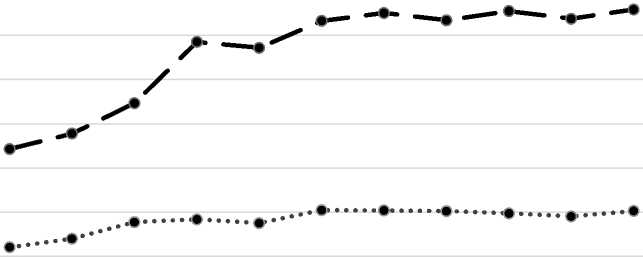
2001 2004 2007 2009 2012 2013 2015 2017 2019 2020 2021
5.0
—• - South of Russia •••••• North of Russia
Fig. 2. Dynamics of the number of people employed in the informal sector for 2001–2021, % 20.
Starting from the second half of the 2000s, the informal sector stopped expanding. The flow from the formal to the informal sector has almost stopped. At the same time, the unemployment rate has tended to decrease over the past twenty years both in the south and in the north of the country. While the south of the Russia has high rates of informality and unemployment, the north is characterized by lower rates of informality and, accordingly, unemployment (Fig. 3).
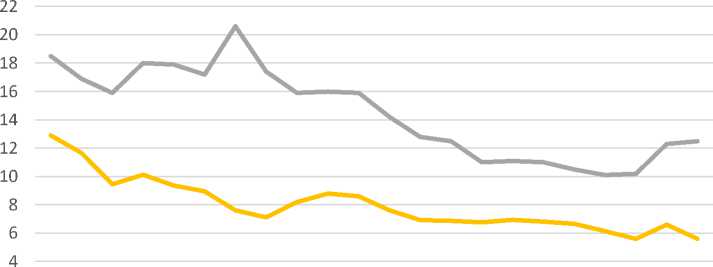
OH(Nm'tLЛ^D^OOQOH(^l(Y>'^LЛ^D^OOOH OOOOOOOOOOHHHHHHHHHNCM ooooooooooooooooooooo
^^^^^MSouth of Russia ^^^^^M North of Russia
Fig. 3. Unemployment dynamics for 2001–2020 21.
In general, as mentioned above, the unemployment dynamics have a downward trend both in the north and in the south of the Russian Federation. Fig. 2 and 3 demonstrate a drop in the unemployment rate and the expansion of the boundaries of the informal sector, which was growing until 2014, and after this year the growth rates significantly decreased, the trend acquired a “flat” character. Thus, has the potential of informality, which cushions the excessive regulation of legislation, which should create space for the development of entrepreneurship, stopped?
Can the informal sector in the south and north of Russia be called the “cradle” of entrepreneurship? In the informal sector of Russia, two tiers can be conventionally distinguished. The first tier is represented by various types of activities that can be united by the word “entrepreneurship”, that is, self-initiative activity of people. The second tier includes workers employed by individuals or individual entrepreneurs (Fig. 4).
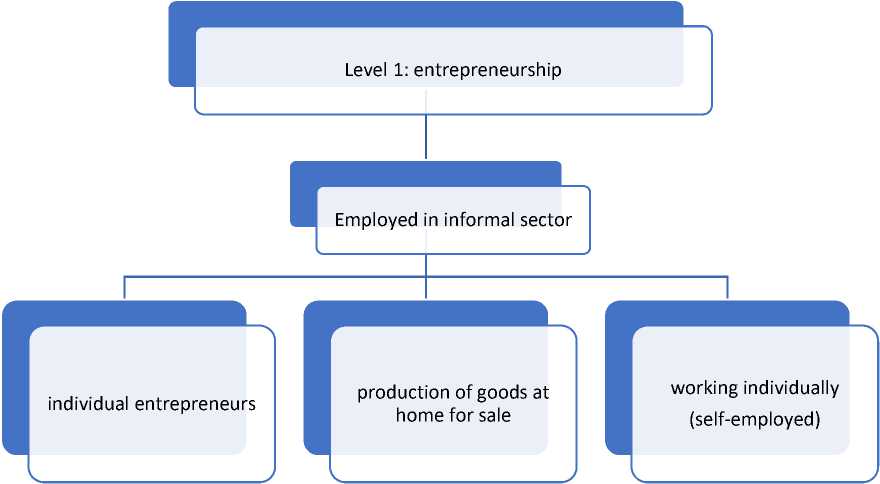
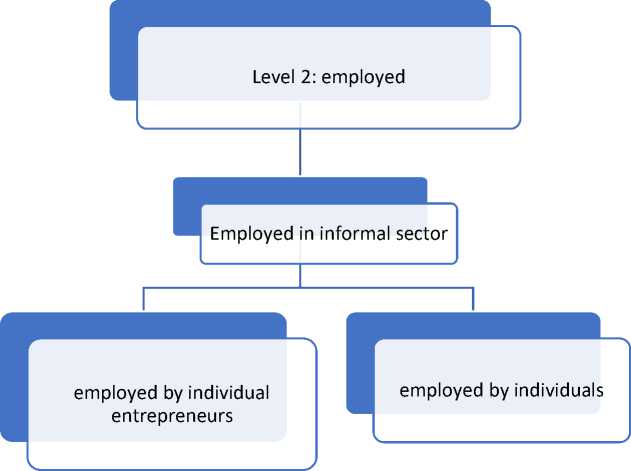
Fig. 4. Employment in the informal sector of the Russian Federation 22.
Russian studies [23; 24] show that the informal sector in our country is represented by people who are hired by individuals, individual entrepreneurs. In the north of Russia, according to labor force surveys, in 2021 the number of people employed in the informal sector aged 15–72 years was 502.0 thousand people, which was 12.9% of the total employed population, the remaining 87.1% of the employed population worked in the formal sector of the economy (Fig. 5).
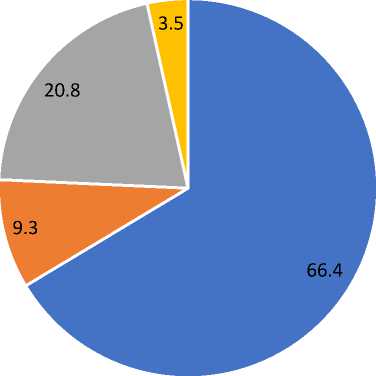
-
■ at an enterprise, in an organization with the status of a legal entity
-
■ in entrepreneurial activity without forming a legal entity
-
■ for hire from individuals, individual entrepreneurs, on farms
-
■ in own household production of agricultural, forestry, hunting and fishing products for sale or exchange
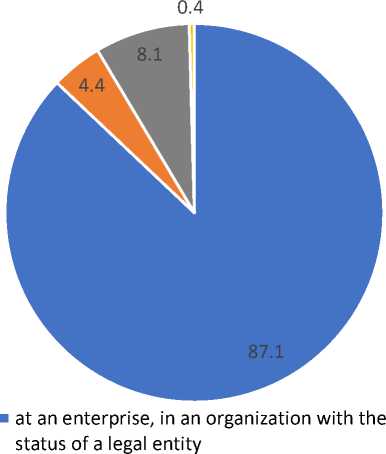
-
■ in entrepreneurial activity without forming a legal entity
-
■ for hire from individuals, individual entrepreneurs, on farms
-
■ in own household production of agricultural, forestry, hunting and fishing products for sale or exchange
Fig. 5. Distribution of employed population aged 15–72 by place of main work, in % of total employed, 2021 (left — south of Russia, right — north of Russia) 23.
The peak of employment in the corporate sector occurred in both southern and northern regions in 2010, provided that we analyze the period from 2008 to 2021, respectively, the lowest employment in the sphere of entrepreneurial activity occurred in 2010, after which corporate employment begins to fall in the regions under consideration, and a narrowing of the corporate sector is observed (Fig. 6).
76.0
64.0
76.0
-
South of Russia
North of Russia
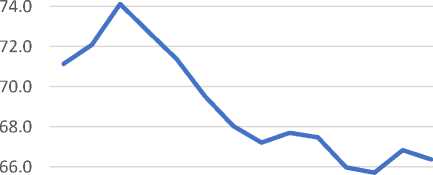

64.0
62.0
62.0
60.0
oomoн(Nm^Ln^D^oomoн ооннннннннннгчгч оооооооооооооо
60.0
OOQOH(^lm'tLЛ^D^OOCnOH OOHHHHHHHHHHCMIN оооооооооооооо
Dynamics of the employed population of the regions of Russia aged 15–72 at an enterprise, in an organization with the status of a legal entity, in % of the total number of employed, 2008–2021 (formal sector).
25.0
20.0
15.0
10.0
5.0
0.0
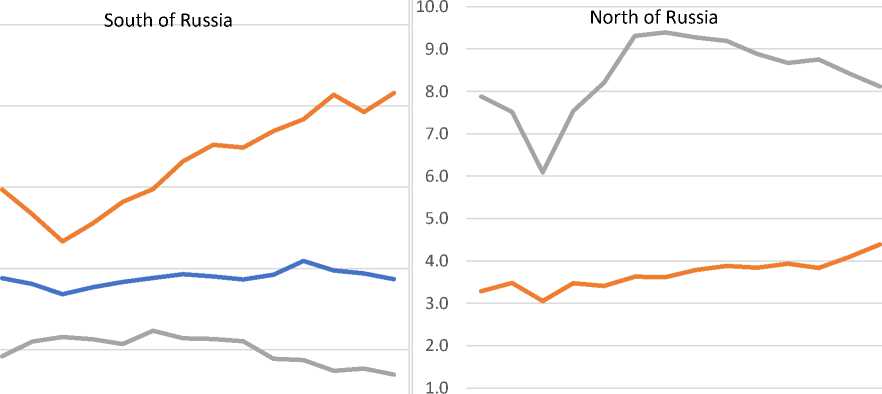
« ■■ ют»in entrepreneurial activity without forming a legal entity
^^^^^«employed by individuals, individual entrepreneurs, and on farms
« ■■■■ в* in entrepreneurial activity without forming a legal entity
■■■■■■■ вemployed by individuals, individual entrepreneurs, and on farms
« ■■■■ ютemployed in their own household in the production of agricultural, forestry, hunting and fishing goods for sale or exchange
« ■■■■■■ вemployed in their own household in the production of agricultural, forestry, hunting and fishing goods for sale or exchange
Dynamics of the employed population of Russian regions aged 15–72 by main place of work, in % of the total n of employed, 2008–2021 (informal sector).
Fig. 6. Dynamics of the employed population of Russian regions aged 15–72 by main place of work, in % of the number of employed, 2008–2021 24.
total
The economic crisis of 2009 affected both the formal and informal sectors of the economy. The number of people employed in the informal sector decreased by 0.1% in the north over 2 years, while in the south of the country this number decreased much more significantly: by 2.6%. Overall, over the period under review, employment in the corporate sector decreased more sharply in the south (by 8%), while in the north the contraction of corporate employment was less pronounced compared to the south (by 4%). However, despite the decline, the corporate sector still provides the bulk of employment (within 87% in the north and 66% in the south).
Entrepreneurial activity of the population in the Russian Federation should decline in the context of the crisis due to the increased level of instability in the economy [25]. Thus, in the southern regions of Russia, since 2010, we have seen a dynamic increase in the number of workers hired by individuals, individual entrepreneurs, in farming, but the share of entrepreneurs was falling. Already after 2018, both the number of people employed in entrepreneurial activity and the number of entrepreneurs was falling in the south of the country. The situation is the opposite in the north: until 2014, there was an increase in the number of workers hired by individuals, individual entrepreneurs, in farming, after which the number of employed began to fall, but the share of entrepreneurs grew. Thus, if the entire increase in informal employment over the past 11 years in the south of the country was ensured by the expansion of informal employment, in the north its predominant form was self-employment (positive dynamics).
To summarize: the informal sector has a significant impact on the economy of the region and the country in several respects. Firstly, it is often one of the main sources of employment for many people, especially in developing countries. It allows people to earn income when the formal sector of the economy is limited. In some countries, the informal sector can account for a significant share of employment and have important social significance for people, as well as make a significant contribution to the regional economy. Illegal enterprises and self-employed workers can generate income, create jobs and participate in trade and production of goods and services. Secondly, the informal sector is often called the “cradle” of small entrepreneurship, while informality is widespread in such industries as retail, services and agriculture. Thirdly, such a property of the informal sector as flexibility and adaptability to changing economic conditions is significant for the economy. The population and entrepreneurs working in the informal sector can quickly respond to changes in demand, adapt to new conditions and offer more flexible prices and working conditions. This is especially important during periods of economic crisis or instability. However, the informal sector also has its negative aspects for economic development. The main disadvantage of the informal sector is tax evasion, as well as lack of accountability to official statistical agencies, which in turn leads to a distortion of the real economic situation and creates problems for financing government programs, including social and infrastructure projects. Thus, the informal sector is important for the regional economy, but its impact can be both positive and negative: depending on the specifics of the country’s economic situation.
Conclusion
This paper assessed the scale of employment in the informal sector from a number of socio-economic indicators in the northern and southern regions of Russia. The results of the study confirmed the heterogeneity of employment in the informal sector at the level of regions in the south and north of Russia. An analysis of employment in the informal sector of the regions under consideration showed that informality is more common in the south of the country. Since climatic conditions are a powerful factor in differentiation in economic development, the study revealed that the southern regions are losing the competition to the northern regions in terms of GRP. However, in the “host” regions of the south, the Krasnodar, Stavropol, Rostov and Volgograd agglomerations emerged, and as a result, competition is intensifying here. In fact, we see that the population growth in the south of the country, represented by the emergence of agglomerations, which are the growth point of small business, has led to an increase in the number of people employed in small businesses, and the share of people employed in small businesses is three times lower than in the federal cities of Moscow and St. Petersburg, and has the same level as in the north of the country (no more than 11.0%).
Transformation processes did not bypass the southern and northern regions of Russia. These processes led to increased competition in the labor market, and in order to successfully adapt to the new conditions, the population began to actively receive education, which led to an increase in the number of people with higher professional education both in the south and in the north, since higher education provides a more “qualitative” level of socialization.
In addition, there is a connection between the GRP and informal employment indicators: southern regions with lower GRP have a greater coverage of informal employment, while the situation in the northern regions is the opposite.
Список литературы Informal Employment: Features in the North and South of Russia
- Guha-Khasnobis B., Kanbur R., Ostrom E., eds. Linking the Formal and Informal Economy: Concepts and Policies. Oxford University Press, 2006, 294 p. DOI: https://doi.org/10.1093/0199204764.001.0001
- Lewis W.A. Economic Development with Unlimited Supplies of Labour. The Manchester School, 1954, no. 22 (2), pp. 139–191. DOI: https://doi.org/10.1111/J.1467-9957.1954.TB00021.X
- Soto de H. The Other Path: The Invisible Revolution in the Third World. Moscow, Catallaxy Publ., 1995, 320 p. (In Russ.)
- Gimpelson V.E., Kapelyushnikov R.I. In the Shadow of Regulation: Informality in the Russian Labor Market. Moscow, HSE Publ., 2014, 535 p. (In Russ.)
- Grossman G. The “Second Economy” of the USSR. Problems of Communism, 1977, pp. 25–40.
- Sokoloff K.L., Engerman S.L. Institutions, Factor Endowments, and Paths of Development in the New World. Journal of Economic Perspectives, 2000, no. 14 (3), pp. 217–232.
- Acemoglu D., Robinson J.A. Why Nations Fail: The Origins of Power, Prosperity and Poverty. New York, Crown Publishers, 2012, 579 p.
- Zubarevich N.V. Spatial Strategy After the Crisis: From the Big Projects to Institutional Moderniza-tion. Journal of the New Economic Association, 2015, no. 2 (26), pp. 226–231.
- Bryzgalin V.A., Nikishina E.N. Is There a Regional Culture in Russia? Opportunities of Using a Soci-ocultural Approach in Economics. Economic Questions, 2020, no. 7, pp. 108–126. DOI: https://doi.org/10.32609-0042-8736-2020-7-108-126
- Terentyeva M.A. Role of Small Business in Providing Employment in the Russian North. Economic and Social Changes: Facts, Trends, Forecast, 2020, vol. 13, no. 4, pp. 108–125. DOI: https://doi.org/10.15838/esc.2020.4.70.6
- Musaeva Kh.M., Shakhbanova Z.I., Kerimova Z.A. Probabilistic Characteristics of the Informal Econ-omy and Its Legalization as a Reserve for the Growth of Tax Revenues of the Budget. Journal of Altai Academy of Economics and Law, 2023, no. 10–3, pp. 377–384. DOI: https://doi.org/10.17513/vaael.3057
- Mkrtchyan N.V. Regional Capitals and their Suburbs in Russia: Net Migration Patterns. Bulletin of the Russian Academy of Sciences. Geographical Series, 2018, no. 6, pp. 26–38. DOI: https://doi.org/10.1134/S2587556618060110
- Zubarevich N.V. Russia’s Agglomerations Development: Trends, Resources and Governing. Social Sciences and Contemporary World, 2017, no. 6, pp. 5–21.
- Auzan A.A., Doroshenko M.E., Eliseev A.N., et al. Institutional Economics: The New Institutional Eco-nomic Theory. Moscow, INFRA M Publ., 2011, 447 p. (In Russ.)
- Acs Z.J., Varga A. Entrepreneurship, Agglomeration and Technological Change. Small Business Eco-nomics, 2005, no. 24 (3), pp. 323–334. DOI: https://doi.org/10.1007/s11187-005-1998-4
- Klyachko T.L. Education in Russia: Main Problems and Possibilities of Solution. Moscow, Delo Publ., 2013, 48 p. (In Russ.)
- Baranov A.Yu., Malkov E.S., Polishchuk L.I., Rokhlitz M., Syunyaev G.R. Measuring Institutions in Russian Regions: Methodology, Sources of Data, Analysis. Voprosy Ekonomiki, 2015, no. 2, pp. 69–103. DOI: https://doi.org/10.32609/0042-8736-2015-2-69-103
- Veredyuk O.V. Informal Employment: Structure and Risk Determinants in Russia. St Petersburg Uni-versity Journal of Economic Studies, 2016, no. 4., pp. 33–48. DOI: https://doi.org/10.21638/11701/spbu05.2016.402
- Akhmadeev D.R. The Analysis of the Factors Influencing on the Development of the Informal Em-ployment in the Region. Journal of Economic Regulation, 2014, no. 4, pp. 92–104.
- Salin V.N., Narbut V.V. Informal Employment of the Population of Russia: Assessment of the Scale and the Impact on Public Finances of the Country. Finance: Theory and Practice, 2017, vol. 21, no. 6, pp. 60–69. DOI: https://doi.org/10.26794/2587-5671-2017-21-6-60-69
- Kunitsyna N.N., Dzhioev A.V. Dependence of Informal Employment on Population Income in Russian Regions: Lessons from the Pandemic. Economy of Regions, 2023, vol. 19, no. 2, pp. 437–450. DOI: https://doi.org/10.17059/econ.reg.2023-2-11
- Barsukova S. Yu. Informal Economics. A Course of Lectures: The Textbook. Moscow, HSE Publ., 2009, 354 p. (In Russ.)
- Barsukova S., Radaev V. Informal Economy in Russia: A Brief Overview. Economic Sociology. The Eu-ropean Electronic Newsletter, 2012, vol. 13, no. 2, pp. 4–12.
- Barsukova S.Yu. Informal Economy. Economic and Sociological Analysis. Moscow, HSE Publ., 2004, 448 p. (In Russ.)
- Gabelko M.V., Murzacheva E.I., Alimova T.A., Chepurenko A.Yu., Obraztsova O.I., Entrepreneurial Activity of Russians in the Crisis. The World of Transformations, 2010, no. 3, pp. 147–162.

